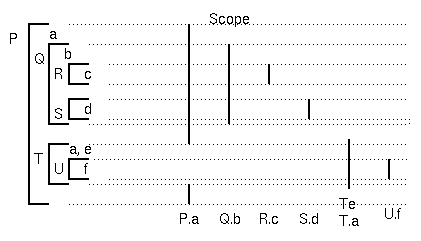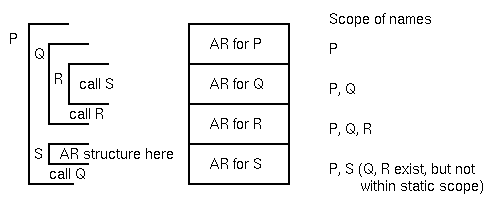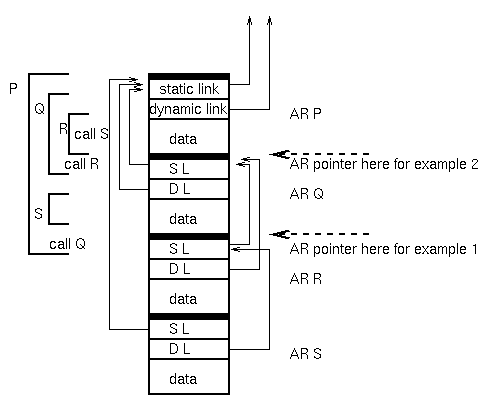
Copy-rule: the effect of subprogram call is same as if code were copied into calling routine. But this is not general:
Activation record created anew at each call - and destroyed at return.
Need an (CIP, CEP) (current instruction pointer, current environment pointer) pair
At call: activation record created, CEP points to it, CIP points to first instruction of subprogram.
At return: activaton record destroyed, CEP set to previous EP, CIP set to previous IP.
The (IP,EP) pair fix the environment under which you execute. But how do we resolve non-local references?
Scope: range of statements over which a variable is known
Static scope - Scope is dependent on the syntax of the program.
Dynamic scope - Scope is determined by the execution of the program.
Static nested scope - A variable is accessible in the procedure it is declared in, and all procedures internal to that procedure, except a new declaration of that variable name in an internal procedure will eliminate the new variable's scope from the scope of the outer variable.
A variable declared in a procedure is local in that procedure; otherwise
it is global.
A review of static scope rules:

Q and T are declarations of procedures within P, so scope of names Q
and T is same as scope of declaration a.
R and S are declarations of procedures in Q.
U is a declaration of a procedure in T.

Problem is: How to manage this execution stack?
Two pointers perform this function:
1. Dynamic link pointer points to activation record that called (invoked)
the new activation record. It is used for returning from the procedure
to the calling procedure.
2. Static link pointer points to the activation record that is global
to the current activation record (i.e., points to the activation record
of the procedure containing the declaration of this procedure).

Example
In R: C := B+A; C local, A and B global
For each variable, get pointer to proper activation record.
Assume AR is current activation record pointer (R).
1. B is one level back:
Follow AR.SL to get AR containing B.
Get R-value of B from fixed offset L-value
2. A is two levels back:
Follow (AR.SL).SL to get act. rec. containing A.
Add R-value of A from fixed offset L-value
3. C is local. AR points to correct activation record.
Store sum into L-value of C
Every variable must have a descriptor.
Descriptors must be of varying size (structures take more room to describe than primitive types).
Often implemented by interpreter (slower anyway, so increased time to check types isn't a factor)
Languages are designed so that a particular binding may be performed at a given time - but it is up to the implementor.
Without static scoping, nothing about nonlocal names can be determined
during translation.
Must be done at execution time (and redone each time statement is
encountered)
begin
boolean b := true;
procedure p;
begin
print (b)
end;
begin
boolean b := false
P
end
end
What is printed?
When subprogram is called with an actual-parameter expression, the
expression is evaluated (usually) at the time of call
The data object that results becomes the actual parameter
Establishing the correspondence
Order of evaluation of parameters is often not specified by language definition. Is in some (left-to-right, or right-to-left)
Transmission types
Disadvantages:
formal parameter is same data type as actual parameter
value copied at time of call and copied back at time of return same as by reference if
Need to know order arguments are copied back.
Need to know whether address is computed again before copying back. XX(i,a[i])
Faster, as no indirect reference
Pass by result
Explicit function Values: may be considered an extra OUT parameter
Used in Algol: theoretical significance
New interest in functional languages - delayed evaluation
Substitute name (in calling environment) for formal parameter
The name location binding is delayed until (and established fresh each time) the formal parameter is encountered.
Implemented by passing parameterless subprograms (thunks) rather than variable name. An expression needs to be evaluated IN the proper environment. Don't have mechanism to do that other than thru procedure call.
Whenever formal parameter is referenced, a call is made to thunk, which evaluates the parameter in the proper (caller) environment and returns proper resulting value (or location)
Example:
procedure R(var i,j: integer); begin var m:integer; m := 5; i := i + 1; j := j + 1; write(i,j); end; m := 2; for(i=0;i<10;i++) c[i]=10*i; R(m,c[m]);
pass by reference: adds 1 to M and c[2]
Pass by name: adds 1 to m and c[3]
Example for Call by Name
b1: begin real x,y;
procedure G(t): name t;
begin integer w;
w := 10;
y := 20;
print t
x = 0
print t
end G;
y := 0.0;
b2: begin real y;
y := 0.5;
x := 1.0;
call G(y-x)
end
end
thunk()
return(y-x)
end;
If name parameter is on left hand side, thunk would have to return the address of the element.
Show what is printed assuming (in turn) each of the parameter passing techniques. If the parameter passing method is illegal for the example, indicate it.
main()
{ integer a,c;
procedure A(int x,int y);
{ integer a=y+7;
c = 4; y=x-1; print (a,x,y,c)
};
a = 1; c=3;
call A(a,a); print(a,c);
c = 5; call A(c,a); print(a,c);
}
main()
{ // no globals
procedure A(int x,int y);
{ integer a=3, c=0;
x=y+7;
c = x+y; print (a,x,y,c)
};
procedure B ();
{ integer a,c;
a = 1; c=3;
call A(a,a); print(a,c);
c = 5; call A(c,a+c); print(a,c);
}
call B();
}
main()
{ integer i, c, a[0..9] = {1,2,3,4,5,6,7,8,9,10};
procedure D(int x,int y);
{ x = 3;
c = i + i *i -5;
print (x,y,c,i)
};
i := 1;
call D(a[i],i++)
print( i,c,a);
}
Corresponding formal parameter is of type subprogram name
Problems
Need to create the correct nonlocal environment
fairly straightforward with static chain method
determine correct static chain pointer for the subprogram parameter and
pass that along as part of the information transmitted with a
subprogram parameter
If types of parameters are not required and separate compilation is possible, cannot do type checking.
As in passing labels as parameters, need an (ip, ep) (instruction pointer, environment pointer) pair
Are three choices of environment
Not appropriate for block structures languages because of static binding of variables
0 begin procedure P(R,b);
value b,R; boolean b; procedure R;
1 integer i;
2 procedure Q;
3 begin
4 i := i + 1;
5 end Q;
6 i := 0;
7 if b then P(Q,not b) else R;
8 print (i);
9 end P;
10 P(P,true);
end
Can't simply pass address - need (cip,cep) pair
Need to update the dynamic chain of activation records.
Creation of an implicit nonlocal environment via current dynamic chain
If no nesting of subprograms (APL, LISP, and SNOBOL4), there is no static structure to base scope rules.
Rule: use most recently created association for X
Trouble: changes between activations requiring dynamic type checking
Only used when dynamic type checking must exist for other reasons
Implementation Issues:
Local environment for each subprogram is made part of its activation
record
At each reference, dynamic chain searched until association is found
which is costly
Need to store identifiers themselves
No base plus offset calculation is possible
Alternative
Central Referencing Environment table:
contains all currently active identifier associations
Figure 7.17
Saves following multiple pointers and searching for matching identifier names.
Search for variable is done during compilation - stack of symbol tables.
Store count of activation records in static chain.
Alternative: The Display Implementation
Avoids following multiple pointers during execution (even though number of pointers to follow is known at compiler time)
On subprogram entry: pointers to static chain of activations are copied into display
With display (chain #, offset)
______________ 0|environment 0| 1|environment 1| 2|environment 2| 3|environment 3| 4|environment 4| ______________Subscript is "how many pointers to follow". Array contains address of the activation record accessed by following the number of pointers indicated by the subscript.